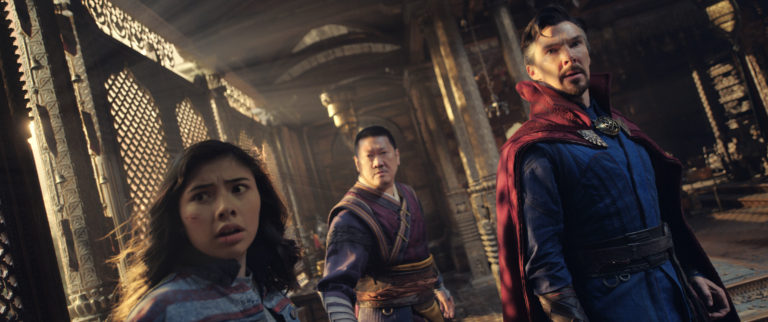Doctor Strange in the Multiverse of Madness (2022 | USA | 126 minutes | Sam Raimi)
It’s not often that you feel sorry for the world’s biggest studio Goliath having the misfortune to follow in the shadow of a plucky indie release, but here we are in the season of dueling multiverses at the multiplex. Let a thousand flowers bloom, but if you have limited time definitely prioritize the Daniels over the Marvel.
Perhaps it’s unfair to compare a movie with a (relatively) modest budget to one with ten times more money helmed by a venerated horror director like Sam Raimi because how could you expect them to be in the same arena? But, like Everything Everywhere All At Once, Doctor Strange in the Multiverse of Madness takes as primary concerns the pursuit of happiness and the ramifications of broken hearts. There’s room for multiple approaches, but you’d think that the advantage should go to the big guy with all the resources. Right there in the title, Marvel’s first theatrical release of the year promises that it’s trippiest sorcerer is about to get into some real deep madness, multiverse style, and yet all of the computers in all of this universe can’t generate anything as mind-blowing as “hot dog hands” universe, let alone anything as emotionally effective as “googly eyes stuck to rocks”.
Marvel’s impeccably orchestrated decade and a half of interconnecting film, television, and (oh right) comic books, has been remarkably sure-footed, reliably entertaining, and almost always a fun hang. I’d consider myself a fan, if not all the way “in the tank” for the MCU, so I was pretty surprised to find that the latest adventures of Marvel’s least charismatic hero struggles for two hours to be anything more than a dull bridge to whatever’s coming next in their multi-modal industrial scale content pipeline.
Without violating the blood oath to “refrain from revealing spoilers, cameos, character developments and detailed story points”, a brief setup. On the eve of attending his ex-girlfriend’s wedding, Steven Strange is having weird dreams about helping a kid escape a monster in a nineties screensaver dimension of pastel colors, twisty crystalline paths, terrible sacrifices, and speaking Spanish. But despite the traumatic imagery, he wakes up safe, still jacked, and speaking English in his palatial magician’s lair. A bit of spellcraft and he’s all tuxedoed up to witness the nuptials of Christine, who we are meant to remember was Strange’s onetime girlfriend, former surgical colleague, and, maybe lightly estranged friend? It’s been six long years of movie time and an unknown number of Marvel years since last she was mentioned, but maybe Rachel McAdams has longstanding contractual obligations. At the ceremony, Strange sits next to Michael Stuhlbarg in a bad wig to remind us that being snapped out of existence sucked and it’s kinda the cosmic sorcerer’s fault. At the reception, his cordial reunion with Christine is immediately broken up by shenanigans in the form of a monster destroying the streets of New York. No one seems to mind that it’s a knock-off from The Suicide Squad or that their lives are potentially in peril and the guests instead treat the ensuing battle as just another part of the day’s entertainment. I guess if you don’t normalize superheroes hastily departing cocktail receptions to turn your city into a bloodless kaleidoscope of lysergic symphonies of property destruction, the one eyed space octopodes have already won.
The source of all the mayhem is a teenager named, America Chavez (Xochitl Gomez) who wears a denim jacket with a Captain America-like star on the back and a rainbow flag pin on the front pocket. Her name turns out to be a great occasion for the script to drop heavy-handed double entendres every time a character muses about what evil someone’s hoping to perpetrate on America, so congrats to the writers on that one. Alas, she’s the same girl from Strange’s dream, which wasn’t really a dream, except in that (confirming so many college dorm room bong hit theories) … dreams are really windows to other realities in the great multiverse (whoa). She’s been fleeing these monsters across dimensions for quite some time, cutting star-shaped windows in the fabric or reality and bouncing out whenever she gets really scared (one would think her pursuer might catch on and send puppies instead of demons, but this is not a movie where anyone makes a straightforward choice even once). Hearing her story, Strange immediately pledges to protect her and quickly deduces, in the first of the uninventive script’s many repetitive not-that-but-this constructions, “this isn’t sorcery, it’s witchcraft”.
It’s here that we get to the final big face from the poster, Elizabeth Olsen’s Wanda Maximoff. In a re-tread from a Spider-Man post-credits scene — highlighting how this movie was probably supposed to be released before No Way Home, given that it confirmed the concept of multiverses that these earthlings find so foreign — Strange pays her a visit to pick her brain about the recent witchery. It’s honestly a little upsetting to learn that none of her Avenger superfriends have even checked in with her since they saved the Universe together by killing her robot husband, let alone after she spent a Disney+ limited series processing her copious grief by enslaving an entire town into a rapidly shifting series of sitcoms. But alas, she’s been laying low, doing her best Martha Stewart homemaking, tending to an apple orchard, reading books, focusing on herself, and missing the imaginary twins she created for herself. It’s great that Matt Shakman gave Olsen eight episodes of WandaVision (at least seven of them great) to explore the complex character’s nuances and severely messed up history of trauma, because there’s very little of that depth to be found for her in Michael Waldron’s script.
Having introduced all the major pieces to the board, the rest of the film becomes a long quest to check out a book from an interdimensional library while fleeing a misguided magical monster. It’s a pursuit that hops around our world to a mountaintop Battle of Hogwarts and a dark temple of forbidden dreamwalking. As promised by the title, the film finds our heroes visiting other universes, but frankly, they aren’t all that mad. One is super weird where New York has a lot more foliage, pizza comes in ball format, red means go, and some of their superheroes are gender-flipped. Another imagines a post-apocalyptic wasteland that looks cobbled together from familiar stock footage, perhaps cast-offs from Loki (the other Disney+ series that’s a pre-viewing homework assignment with more fun and depth than anything here).
Opportunities to use these exotic settings are largely missed, as a bland-looking first half with dull action sequences plays background to an unholy number of conversational information dumps. Main characters remain flat, largely because these are some of Marvel’s worst served characters. They’ve never really known what to do with Wanda, from the ever-shifting scale of her powers to seriously reckoning with her very dark history. Olsen does what she can, but she’s no match for what the film has in store for her: an atrocious culmination of a persistent urge to reduce and simplify rather than embrace complexity. Similarly, with his aloof demeanor, self-certainty, and humor deficit, they’ve strained to find any way to make Benedict Cumberbatch’s Doctor Strange anything approaching relatable or likeable. He’s a prickly character and efforts to ground the spacey wizard to mere human concerns come across as half-baked cliches about whether he’s truly happy or recovered, not from causing half of life in the universe to snap out of existence, but from an amicable break-up in his mid-twenties. It often feels like a lot of desperate retconning and uncreative reaching to find something to hang a story around.
It’s not until well into the film’s second hour that Raimi wrestles control of the film’s visual and storytelling aesthetic. As the film approaches its third act, the Marvel Starter Kit aesthetic tenuously gets shoved aside with flashes of weirdness. The core of the story is undercooked, but at least as it lumbers toward a finale, the horror director is able to populate the periphery with some gory kills, subversion of fan service, and an inventively grotesque climax that recognizes the inherent humor in all of this ridiculousness. Bless Sam Raimi, but it isn’t enough. Instead the better bits hint at what this film might’ve been if it wasn’t so labored with needing to be one piece among many in a multi-year jigsaw puzzle of content.
Doctor Strange in the Multiverse of Madness arrives in theaters on May 6th
Images courtesy Marvel / Walt Disney Studios




